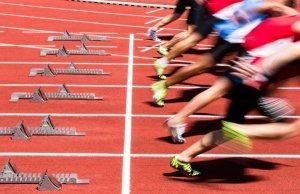Muscle Fibers and Their Functions

Usually, we see the human body as a whole. Then, we divide it into large regions, such as the face or the extremities. However, each part has lots of smaller parts that give it certain characteristics. In this article, we’re going to talk specifically about muscle fibers and what they do.
This same thing happens with our muscles. We see a muscle covered by skin and we think of it as a block that contracts and relaxes. However, each muscle has muscle fibers, and they have different functions.
What muscle fibers are there?
The human body has three types of muscle fibers: skeletal, cardiac, and smooth. The skeletal ones make up the muscles, the cardiac ones cover our heart, and the smooth ones are in our internal organs.
A big difference between the three types is that we actively control skeletal muscles, while the nervous system controls the cardiac and smooth muscle fibers.
Therefore, our bodies make sure that the heart beats fast enough, and that the stomach fills and empties as we eat and digest food. Logically, we control whether we get a glass of water, walk, or turn our heads when we hear a door open.
As we explained in the first paragraph, in this article, we’ll focus on muscle fibers, specifically skeletal fibers.
Skeletal muscle fibers
Within skeletal muscle fibers, there are different categories. Each muscle has slow, intermediate, and fast fibers, in different proportions based on what they do.

Each type of fiber will contract to do a specific task. Also, they can move together to make a movement that needs more than one type.
Slow fibers
Slow fibers are also known as red fibers because of their color, as they have lots of myoglobin reserves. Thanks to these reserves, the muscles contract for long periods of time. However, their small diameter means they can’t exert much force.
The muscles that maintain posture, such as paravertebral muscles, contain lots of slow fibers. This way, we can spend hours walking or standing without hunching our backs. Also, we use these muscles a lot when we run marathons or ride a bike.
Intermediate fibers
These fibers, also known as fast type II-A fibers, are halfway between slow and fast. In fact, they’re able to exert more force than slow ones, but they also tire more quickly. They can help both types of muscle fibers if they become fatigued. In addition, they contract on their own to exert medium force efforts.
Fast fibers
The fast fibers, of II-B, serve to generate great power for a short amount of time. They don’t have a lot of oxygen, but they are thick. So, we use them when we lift weights or run a sprint. They have a lot of strength, but they tire easily.

Muscle fibers: train them according to your specialty
Now that you know there are different types of muscle fibers, you need to apply this practically in your daily activities. For example, if you want to practice an explosive sport, you’ll need to train the fast fibers. On the other hand, if you want to run medium distances, you’ll want to strengthen the intermediate and slow ones.
Knowing this will also help you understand how athletes from different disciplines have such different body structures, even though they’re all athletes. This explains why long-distance runners have developed the slow, fine fibers in their legs.
On the other hand, pole vaulters need to make a single gesture as strongly as possible, which is why they need to develop the fast fibers in their pecs and shoulders.
Usually, we see the human body as a whole. Then, we divide it into large regions, such as the face or the extremities. However, each part has lots of smaller parts that give it certain characteristics. In this article, we’re going to talk specifically about muscle fibers and what they do.
This same thing happens with our muscles. We see a muscle covered by skin and we think of it as a block that contracts and relaxes. However, each muscle has muscle fibers, and they have different functions.
What muscle fibers are there?
The human body has three types of muscle fibers: skeletal, cardiac, and smooth. The skeletal ones make up the muscles, the cardiac ones cover our heart, and the smooth ones are in our internal organs.
A big difference between the three types is that we actively control skeletal muscles, while the nervous system controls the cardiac and smooth muscle fibers.
Therefore, our bodies make sure that the heart beats fast enough, and that the stomach fills and empties as we eat and digest food. Logically, we control whether we get a glass of water, walk, or turn our heads when we hear a door open.
As we explained in the first paragraph, in this article, we’ll focus on muscle fibers, specifically skeletal fibers.
Skeletal muscle fibers
Within skeletal muscle fibers, there are different categories. Each muscle has slow, intermediate, and fast fibers, in different proportions based on what they do.

Each type of fiber will contract to do a specific task. Also, they can move together to make a movement that needs more than one type.
Slow fibers
Slow fibers are also known as red fibers because of their color, as they have lots of myoglobin reserves. Thanks to these reserves, the muscles contract for long periods of time. However, their small diameter means they can’t exert much force.
The muscles that maintain posture, such as paravertebral muscles, contain lots of slow fibers. This way, we can spend hours walking or standing without hunching our backs. Also, we use these muscles a lot when we run marathons or ride a bike.
Intermediate fibers
These fibers, also known as fast type II-A fibers, are halfway between slow and fast. In fact, they’re able to exert more force than slow ones, but they also tire more quickly. They can help both types of muscle fibers if they become fatigued. In addition, they contract on their own to exert medium force efforts.
Fast fibers
The fast fibers, of II-B, serve to generate great power for a short amount of time. They don’t have a lot of oxygen, but they are thick. So, we use them when we lift weights or run a sprint. They have a lot of strength, but they tire easily.

Muscle fibers: train them according to your specialty
Now that you know there are different types of muscle fibers, you need to apply this practically in your daily activities. For example, if you want to practice an explosive sport, you’ll need to train the fast fibers. On the other hand, if you want to run medium distances, you’ll want to strengthen the intermediate and slow ones.
Knowing this will also help you understand how athletes from different disciplines have such different body structures, even though they’re all athletes. This explains why long-distance runners have developed the slow, fine fibers in their legs.
On the other hand, pole vaulters need to make a single gesture as strongly as possible, which is why they need to develop the fast fibers in their pecs and shoulders.
All cited sources were thoroughly reviewed by our team to ensure their quality, reliability, currency, and validity. The bibliography of this article was considered reliable and of academic or scientific accuracy.
- Coll-Risco I., Camiletti-Moirón D., Tirado D.J., Nebot E., Andrade A., Martínez R. et al . Efectos del ejercicio aeróbico interválico, combinado con entrenamiento de fuerza y de la restricción calórica, sobre la composición corporal de ratas obesas. Rev Andal Med Deporte [Internet]. 2017 [citado 2019 Nov 26] ; 10( 1 ): 3-8.
- Barbosa Murillo J. A. P., Rodríguez M. N. G., Hernández H. de Valera Y. M., Hernández H. R. A., Herrera M. H. A.. Masa muscular, fuerza muscular y otros componentes de funcionalidad en adultos mayores institucionalizados de la Gran Caracas-Venezuela. Nutr. Hosp. [Internet]. 2007 Oct [citado 2019 Nov 26] ; 22( 5 ): 578-583.
- Vázquez-Guerrero Jairo, Moras Gerard. Cambios en la arquitectura muscular y en la velocidad de ejecución de sentadillas en VersaPulley en condiciones estables e inestables en jugadores junior de baloncesto de élite durante una temporada. CPD [Internet]. 2015 Sep [citado 2019 Nov 26] ; 15( 3 ): 243-252.
This text is provided for informational purposes only and does not replace consultation with a professional. If in doubt, consult your specialist.








